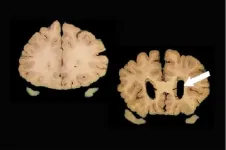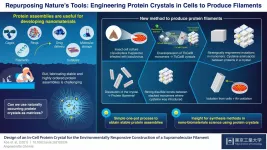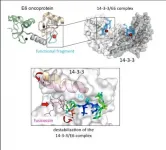Freeze! New model to help protect ships from ice accretion
2021-04-26
(Press-News.org) Researchers from Skoltech (Russia) and their colleagues from SINTEF (Norway) have developed a mathematical model of freezing water droplets moving in cold air. This model is a part of a joint RFBR-supported Russian-Norway research project. The project is focused on predicting ice accretion on ships and other offshore structures operated in Arctic climate, which may interfere with their proper functioning and endanger crew members and cargo. The paper was published in the journal Energies.
Ships travel in cold northern waters under constant bombardment by tiny water droplets populating the chilly air. The droplets are expelled into the air at the impact of sea waves on the ship hull or other surfaces. When they reach the ship's substructure, these semi-frozen droplets can either bounce off or stick. The probability of the droplets' sticking to the wall depends on their freezing state, i.e., completely frozen droplets simply bounce off, while others lead to different scenarios. If too many of them stick, the structure accumulates ice, which can threaten its stability and cause surface erosion. There are models describing this process for aircraft and electrical power lines, but so far, there are no simulation tools that accurately describe ice accretion at sea and not require a lot of computational resources.
"The ice accretion process consists of a few important stages. First, the droplets are generated from sea wave impact at a variety of sizes and speed. Then, they fly towards the ship in the form of a sea spray cloud, while the distribution of droplet size, location and velocity in the cloud is unknown. Finally, at impact with a surface, droplets contribute to the ice accretion with certain efficiency. Some droplets do not add up to the ice layer, while others become a part of it. These processes are hardly studied and contain many unknown parameters, which makes numerical simulations difficult. At Skoltech, we develop a few special experimental setups to obtain the unknown parameters in the laboratory and at sea. Our experimental results become a part of a complex model of ice accretion process. We also contribute with models of some subprocesses of the icing", senior research scientist Svyatoslav Chugunov, a coauthor of the paper, says.
Iskander Akhatov, professor and director of the Skoltech Center for Design, Manufacturing and Materials, professor Dmitry Eskin, MSc graduate Doston Shayunusov and Svyatoslav Chugunov built just such a model of the cooling of a droplet, its partial solidification, and its further interaction with the solid wall surface.
The model consists of two parts: the first part simulates the droplet partial freezing after leaving the core liquid, and the second part simulates the interaction between the droplet and the solid wall. The authors of the paper note that the new model is simple and suitable only for an approximate analysis, but they intend to incorporate it into a more complex 3D simulation tool.
"This work is in the active stage right now. We are assembling an experimental setup to measure distribution of the droplets' location and size in the sea spray cloud from a ship. We would make additional efforts to measure droplets velocity while running the major experiments. These studies are in our plan of work for 2021," Dr. Chugunov says.
Once the project is completed, scientists expect to get an open-source numerical code for realistic simulations of wave impact on a ship, to simulate seawater droplets' propagation in cold air and their deposition onto ship surfaces.
"This numerical tool could be applied to different types of existing and future marine structures to predict ice accretion under variety of climatic conditions. For existing structures, the plan of risk mitigation for ice accretion events could be improved. For prospective developments, the shape and location of ship components may be altered to reduce the effects of ice formation on ship functioning," Chugunov notes.
INFORMATION:
ELSE PRESS RELEASES FROM THIS DATE:
2021-04-26
Ishikawa, Japan - Robots today have come a long way from their early inception as insentient beings meant primarily for mechanical assistance to humans. Today, they can assist us intellectually and even emotionally, getting ever better at mimicking conscious humans. An integral part of this ability is the use of speech to communicate with the user (smart assistants such as Google Home and Amazon Echo are notable examples). Despite these remarkable developments, they still do not sound very "human".
This is where voice conversion (VC) comes in. A technology used to ...
2021-04-26
Just one third of people in the UK managed to access the hospital care they needed at the peak of the first wave of the Covid-19 pandemic - according to new research from the University of East Anglia.
A new study published today looks at the extent to which people managed to access NHS healthcare in April 2020, and as lockdown restrictions eased.
The researchers found that, despite high levels of unmet need, there was equal access to NHS hospital care for people at different levels of income. And the NHS principle of equal treatment for equal need was upheld.
However, people on higher incomes had better access to GP consultations, prescriptions and medical helplines at ...
2021-04-26
Steroids should not be used to treat smell loss caused by Covid-19 according to an international group of smell experts, including Prof Carl Philpott from the University of East Anglia.
Smell loss is a prominent symptom of Covid-19, and the pandemic is leaving many people with long-term smell loss.
But a new study published today shows that corticosteroids - a class of drug that lowers inflammation in the body - are not recommended to treat smell loss due to Covid-19.
Instead, the team recommend 'smell training' - a process that involves sniffing at least four different odours twice a day for several months.
Smell loss expert Prof Carl Philpott from UEA's Norwich Medical School, said: "The huge rise in smell loss caused by Covid-19 has created an unprecedented worldwide demand for ...
2021-04-26
According to the Motorik-Modul-Längsschnittstudie (MoMo, Motor Module Longitudinal Study) of Karlsruhe Institute of Technology (KIT) and Karlsruhe University of Education (PHKA), mental health of children and adolescents decreased during the first lockdown. For children aged between 4 and 10 years and for girls irrespective of their age, mental health was found to promote physical activity during Covid-induced lockdown in spring 2020. This is reported in Children (DOI: 10.3390/children8020098).
"The impacts of the lockdown on children and adolescents is discussed widely," ...
2021-04-26
Deaths of people who suffered strokes increased during the first lockdown compared to the three previous years, new data analysis has found. Despite the pandemic, health care quality was maintained at a high level.
In their paper, published today in Stroke American Heart Association, research teams from King's College London, Guy's and St Thomas' NHS Foundation and the Sentinel Stroke National Audit Programme (SSNAP) analysed the data of 184,017 patients admitted to hospital with confirmed stroke during October-April periods across four consecutive years. This patient data were collected from 114 hospital trusts in England, Wales and Northern Ireland.
Starting from the third week of February 2020 there was ...
2021-04-26
One of the biggest challenges in Alzheimer's research is to identify biomarkers that can identify people who are at risk of developing dementia. Biomarkers could be used to screen people so they might be helped before they develop dementia.
Researchers have focused primarily on three such biomarkers. Two are Alzheimer's-related proteins, amyloid and tau. Amyloid forms clumps in brains, and tau forms skeins of filaments called neurofibrillary tangles. Both can be detected in cerebral spinal fluid or by specialized positron emission tomography (PET) scans. The third marker, brain atrophy, can be seen with CT or MRI scans.
To guide researchers, the National Institute on Aging and the Alzheimer's Association ...
2021-04-26
Proteins are undoubtedly some of the most fascinating biomolecules, and they perform many of the functions that (in our eyes) separate life from inanimate matter. Multi-molecular protein assemblies even have large-scale structural functions, as evidenced by feathers, hair, and scales in animals. It should come as no surprise that, with progress in advanced nanotechnology and bioengineering, artificial protein assemblies have found applications in a variety of fields, including catalysis, molecular storage, and drug delivery systems.
However, producing ordered protein assemblies remains challenging. It is particularly difficult to get monomers, the building blocks of proteins, to assemble stably into the desired structures; this generally ...
2021-04-26
Although most oncological diseases are not infectious, some viruses can cause cancer. According to the World Health Organization, two HPV subtypes account for 70% of cervical cancer cases and pre-existing conditions. Moreover, HPV considerably increases the risks of other types of cancer. Within an infected cell, a viral protein called E6 binds with human proteins from the 14-3-3 family. 14-3-3 proteins are present in cells of all eukaryotic organisms and can interact with hundreds of other important players of intracellular processes to regulate cell division, gene activity, metabolism, cell death, and intracellular ...
2021-04-26
Researchers from Tel Aviv University have created an artificial intelligence platform that can identify the specific proteins that allow bacteria to infect the intestines - a method that paves the way for the creation of smart drugs that will neutralize the proteins and prevent disease, without the use of antibiotics. Participating in the study, which was published in the prestigious journal Science, were Ph.D. student Naama Wagner and Prof. Tal Pupko, head of the Shmunis School of Biomedicine and Cancer Research at the Faculty of Life Sciences and the new Center for Artificial Intelligence ...
2021-04-26
Prof. PAN Jianwei and his colleagues from the University of Science and Technology of China of the Chinese Academy of Sciences investigated the high-loss free space high-precision time-frequency dissemination experiment between remote locations, simulating the high-precision time-frequency high-orbit satellite-ground links in the channel loss, atmospheric noise, and transmission delay effects.
This link experiment exhibits that the instability of the time-frequency transfer via a satellite in middle-high earth orbits might reach E-18 at 10,000 s, enabling ...
LAST 30 PRESS RELEASES:
[Press-News.org] Freeze! New model to help protect ships from ice accretion





